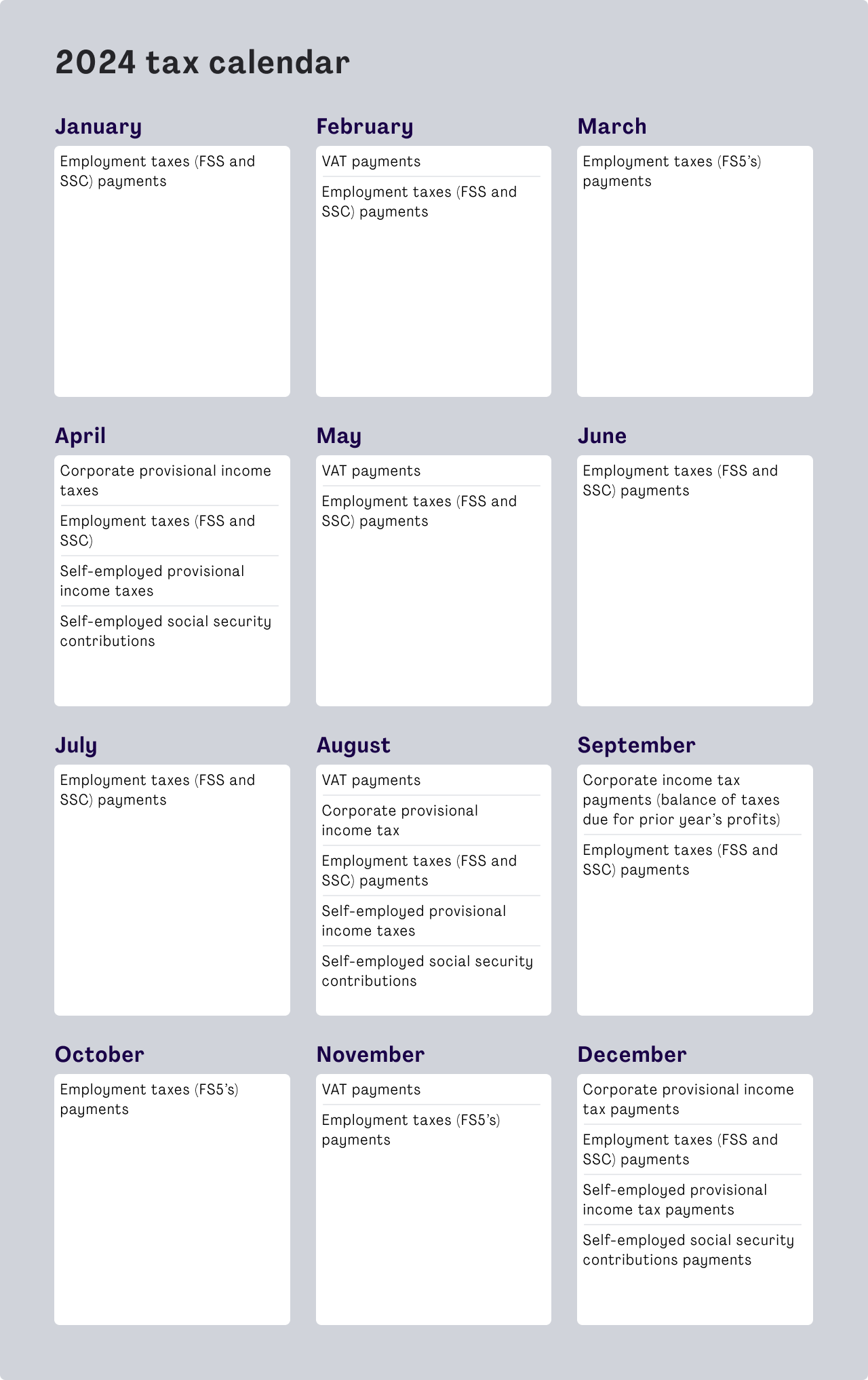On the wamo blog we’ve shared a lot of information about various taxes, what they mean and whether or not they apply to you and your business. In Malta, there are several types of taxes, each with its own payment schedule. In this article we’ll be looking specifically at taxation in Malta – particularly when and how to pay all your taxes. We will walk you through the tax payment deadlines for Value Added Tax (VAT), income tax, employment tax, FSS (Final Settlement System), and National Insurance.
Why you need to track your tax deadlines
Tracking tax deadlines is an important way for you to be responsible with regards to your financial management. It will make sure you avoid financial penalties, remain compliant with tax laws, plan your finances effectively, prepare tax information accurately, and plan how best to save from your taxes. For your convenience, here's a Tax Deadline Calendar for Malta:

Value Added Tax (VAT)
Value Added Tax (VAT) is a consumption tax paid on the value added to goods and services at each stage of production or distribution. In Malta, VAT is payable in four installments throughout the year.
Payment deadlines: VAT payments in Malta follow a specific schedule to help you manage your tax obligations effectively. The payment deadlines for VAT are as follows:
May: First VAT installment due
August: Second VAT installment due
November:Third VAT payment due
February: Fourth and final installment due
These payment dates are designed to make sure there is a regular and consistent approach to meeting your VAT payments throughout the year. As with any tax deadlines, it’s important to stay on top of these to avoid penalties.

How to calculate VAT: To calculate your VAT liability, you need to subtract the input VAT (VAT on purchases) from the output VAT (VAT on sales). The difference is the amount you owe to the tax department. The standard VAT rate in Malta is 18%, but reduced rates may apply to certain goods and services, such as 7% for accommodation services.
How to pay VAT: You can make VAT payments conveniently by visiting the official portal of the VAT department. To pay your VAT, go to the Commissioner for Revenue website VAT payment page, where you can easily submit your payment. After completing the transaction, you will get confirmation that you’ve paid. Make sure to use the official payment channel.
Check out this article on our blog for a comprehensive guide to Malta’s VAT landscape in 2023.
Provisional Tax (PT)
Provisional Tax (PT), also known as "Provisional Income Tax," is an essential part of tax compliance for companies operating in Malta.It is there to make sure that businesses make timely contributions to their annual tax liability. PT payments are structured to be made in three installments during the tax year. To help you understand and manage your provisional tax obligations, here's a breakdown of the PT payment process:
Payment deadlines: PT payments in Malta are scheduled to be made every four months during the basis tax year. The payment deadlines are as follows:
First installment (20%): The initial PT payment, equivalent to 20% of the total estimated tax liability, is due within the first four months of the basis tax year.
Second installment (30%): The second PT installment, comprising 30% of the estimated tax liability, is to be paid in the subsequent four-month period.
Third installment (50%): The final PT installment, amounting to 50% of the projected tax liability, is due in the last four months of the basis tax year.
These staggered payment dates are designed to distribute the financial burden and help companies manage their tax obligations more efficiently. Staying compliant with these deadlines is crucial to avoid penalties and maintain good standing with Maltese tax authorities.
How to calculate PT: The calculation of Provisional Tax is primarily based on the last self-assessment filed by the company. Companies are required to estimate their annual tax liability and divide it into the three aforementioned installments for payment during the basis tax year.
How to pay PT: To make your PT payments conveniently, you can access the official portal of the Maltese tax department. Visit the Commissioner for Revenue website's PT payment page to initiate your payment.
If you need more information on anything related to corporate income tax in Malta, have a look at this article on the wamo blog.
FSS (Final Settlement System)
The FSS, or Final Settlement System, in Malta is made up of different employment-related deductions and contributions, including income tax.
FSS payments, along with income tax, are due on a monthly basis. This means that employers must pay FSS contributions each month, in alignment with the employees' salaries and deductions.
How to calculate FSS: The calculation of FSS includes income tax and other related deductions. The specific calculation depends on the employee's salary, specific deductions, and social security contributions.
How to pay FSS:
As with paying other taxes in Malta, employers can conveniently make FSS payments through the official online portal provided by the Commissioner for Revenue. Visit the Commissioner for Revenue's Online Services for Employers to make your FSS payments accurately.
National Insurance
National Insurance contributions in Malta fund different kinds of social benefits, including healthcare and pensions. The specific contribution rate changes depending on income levels. The rate that needs to be paid is 15% of your net annual income.

National Insurance contributions are due on a monthly basis, making them a regular financial obligation.
How to calculate National Insurance: The calculation involves working out the contribution amount based on the employee's salary and the relevant contribution rates, which are based on income levels.
How to pay National Insurance: For National Insurance payments, consult the detailed information provided on the Commissioner for Revenue's National Insurance details page.
To better understand Malta’s corporate social security tax, have a look at this article on the wamo blog.
You should have a good understanding of all the taxes you need to be aware of when running a business from or in Malta. In this article we’ve provided you with all the relevant deadlines as well as a handy calendar. Of course, make sure to check with official channels in case there are any changes in future, and it’s always useful to work with a professional tax person to make sure you stay compliant with all your tax obligations!







